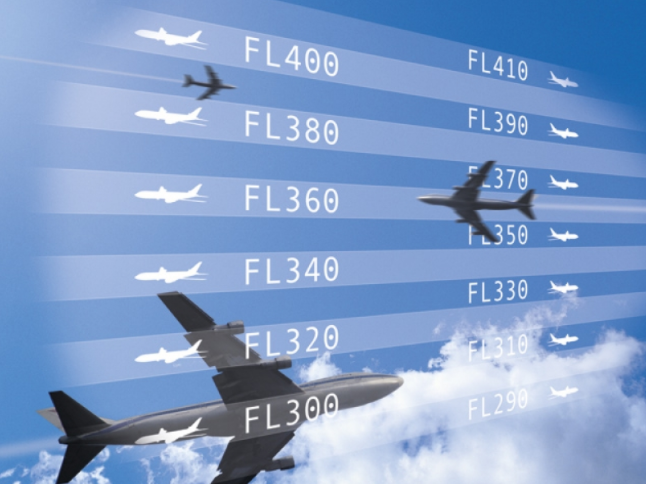Introduction to Reduced Vertical Separation Minima (RVSM)
1982 saw considerable efforts focused on the feasibility of RVSM. Under the overall guidance of the ICAO Review of the General Concept of Separation Panel (RGCSP), several States initiated a series of comprehensive work programmes to examine the feasibility of reducing the vertical separation minimum above FL 290 from 600m (2,000 ft) to 300m (1,000 ft). (FL410 (inclusive), where aircraft are vertically separated by 1000 feet, instead of 2000 feet.
Studies were made by member states of EUROCONTROL (France, Germany, the Kingdom of the Netherlands, and the United Kingdom – in an extensive co-operative venture which was co-ordinated by the EUROCONTROL Agency), Canada, Japan, the former Union of the Soviet Socialist Republics (USSR), and the United States of America (USA).
The primary objectives of these studies was to decide whether a global implementation of the Reduced Vertical Separation Minimum (RVSM) :
a) would satisfy predetermined safety standards;
b) would be technically and operationally feasible, and
c) would provide a positive Benefit to Cost ratio.
These studies employed quantitative methods of risk assessment to support operational decisions concerning the feasibility of reducing the vertical separation minimum. The risk assessment consisted of two elements.
The level of risk that is deemed acceptable is termed the Target Level of Safety (TLS). The basis of the process of risk estimation was the determination of the accuracy of height keeping performance of the aircraft population operating at/above FL 290. This was achieved through the use of high precision radar to determine the actual geometric height of aircraft in straight and level flight. This height was then compared with the geometric height of the flight level to which the aircraft had been assigned to determine the total vertical error (TVE) of the aircraft in question.
Given this knowledge, it was possible to estimate the risk of collision solely as a consequence of vertical navigation errors of aircraft to which procedural vertical separation had been correctly applied.
The RGCSP then employed an assessment TLS (2.5 x 10-9 fatal accidents per aircraft flight hour) to assess the technical feasibility of a 300m (1,000 ft) vertical separation minimum above FL 290 and also for developing aircraft height keeping capability requirements for operating with a 300m (1,000 ft) vertical separation minimum.
Using the assessment TLS of 2.5 x 10-9 fatal accidents per aircraft flight hour, the RGCSP concluded that a 300 m (1,000 ft) vertical separation minimum above FL 290 was technically feasible without imposing unreasonably demanding technical requirements on the equipment and that it would provide significant benefits in terms of economy and en-route airspace capacity.
In reaching this conclusion on technical feasibility, the panel identified the need to establish:
(a) airworthiness performance requirements in the form of a comprehensive Minimum Aircraft Systems Performance Specification (MASPS) for all aircraft which would be operated in RVSM airspace;
(b) new operational procedures; and
(c) a comprehensive means of monitoring for safe operation.
In the USA, RTCA Special Committee SC 150 was established with the purpose of developing minimum system performance requirements, identifying required aircraft equipment improvements and operational procedure changes and assessing the impact of RVSM implementation on the aviation community SC 150 served as the focal point for the study and development of RVSM criteria and programmes in the US from 1982 to 1987.
In Europe, EUROCAE Working Group WG 30 was established in 1987 to prepare an altimetry specification appropriate for 300m (1,000 ft) vertical separation above FL 290. Draft specification documents produced in WG-30 formed a major input to the technical documentation on altimetry requirements developed by the ICAO North Atlantic System Planning Group/Vertical Studies Implementation Group.
ICAO Doc 9574 provides guidance on RVSM implementation planning, airworthiness requirements, flight crew procedures, ATC considerations and system performance monitoring.
Sofema Aviation Services (www.sassofia.com) offers multiple EASA Compliant Regulatory and Vocational Training Courses including RVSM – for details please see the website or email office@sassofia.com




